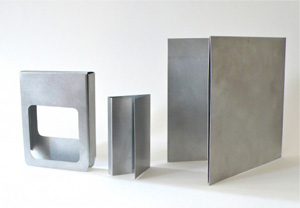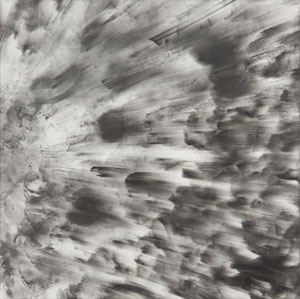Listen to the Music
John Haberin New York City
Jennie C. Jones, John Zorn, and Ericka Beckman
Ever tempted to dismiss Minimalism as a little too quiet and a little too apart? Jennie C. Jones is listening. Meanwhile John Zorn sets his instrument aside now and then for art. At the Drawing center alongside Ericka Beckman, it does not look minimal in the least.
For all its spareness, Minimalism offers plenty to see for those who take time to look. No, make that because of its spareness, which gives one time and space to see. For Jones, that means time and space to hear as well. You may not hear anything right away, though, for you will be busy enough at the Guggenheim with her installation, paintings, and works on paper. Her installation's sound component may catch up with you only gradually, when you realize that you have been listening all along. It allows you to feel as if you are alone with the art even in a museum. As the rubes in Shakespeare's The Tempest say to one another, in hope of reassurance, "this isle is full of noises." 
If Zorn, in turn, leaves a single image, it is of himself wielding a mean tenor sax. It suits a musician who dares to think for himself and on the fly. He has fronted jazz bands and stretched the limits of rock. He has taken on the rigor and premeditation of a modern composer and arranger, too, from extended suites to bursts of counterpoint. You are as likely to hear him on a sound track as in the concert hall. Just try to pin him down. Just try, in fact, to call him a creative artist, but the Drawing Center shows him thinking in pictures.
As a postscript, Jones takes her silent music to the Met roof for 2025 New York summer sculpture, as Ensemble. I invite you to read my review from the Guggenheim in 2022, which follows, but her command of music, geometry, and silence has only grown. Tall slabs, a trapezoid, and a V-shape seem to change in proportions as one circulates. Her colors run to a deep red that could pass for Minimalism's dark steel, but with accents white concrete and blood red that evoke soundproofing, the museum's travertine stone, and a scream. Pins and wires allude to the bridge of a violin or the single string of Mississippi blues. If one part of her trilogy makes her think of an Aeolian harp, its melodies celebrated by Samuel Taylor Coleridge in poetry in 1796 and driven by the wind, this is Minimalism as poetry waiting to be heard.
Relishing the quiet
Jones prefers quiet noises, just as her mixed media nurture the quiet. She works not with paint on canvas, but rather the materials to eliminate unwanted noises, felt and acoustic panels. You may never have noticed before their contrasting texture or their similarity to Minimalism itself. Jones titles one work for Agnes Martin, and her influence is unmistakable in the simple divisions of a work between panels or along horizontals—and the gradations of dark and gray. When a red panel or gray diagonal intrudes, it is all the more resonant. When a red slice tops a panel, where you can barely see it, its "aura," as she puts it, is the visual equivalent of the hum.
Jones has the lower floors of the Guggenheim ramp, just after another woman with a feel for quiet, Etel Adnan. A musical score, the form of her works on paper, is for her what landscape is for Adnan. Music has long had a place in Minimalism as well—an entire genre of music with such composers as John Adams and Philip Glass, also the subject of portraits by Chuck Close. While most definitely not a Minimalist, John Cage recognized the visual potential of a score, and he will always be famous for less than five minutes of silence. Cage also embraced chance, while Jones leaves nothing to chance, and she is not one to count off the seconds. Still, the staff lines in her scores are compositions in themselves.
Is the parallel between art and music only a metaphor? It may be only figurative language, but it has entered English. One does speak of a quiet composition or go to a museum in search of quiet. Jones finds the parallels in technical and informal language alike—most often in digital music and analog art. Titles speak of Soft, Pitchless Oxide Edge and Toward the Pedal Point, while a bright red painting is a Tone Burst. The show's title, "Dynamics," refers to music's gradations in volume, but dynamics in physics (as opposed to statics) is the study of forces and motion. And she does think of her paintings as "active surfaces" and the "physical residue" of sound.
Panels like these are also elements of architecture, and their interdisciplinary art extends there as well. The view down from the ramp onto the two-level High Gallery offers a glimpse of red accents on the top of paintings that one might otherwise have missed. When (rarely) curves enter a drawing, they pick up on Frank Lloyd Wright and the Guggenheim. Quiet being what it is, one might find oneself talking around another point of reference, too. Jones is black, and past shows have been eager to find markers of African American identity in her art. They have also featured objects that this small show takes pains to omit.
She contributed a SONY Walkman to a show of "conceptual art and identity politics" and looped audio cables to a tribute to Romare Bearden, both at the Studio Museum in Harlem. She appeared there among the emerging artists in "Freestyle" as well. One of her scores turned up just last year in "Grief and Grievance" at the New Museum, a show about white grievances and black grief. Is Jones out to leave all that behind, in favor of recent work and an homage to Martin? The Guggenheim quotes her dismissal of black abstraction as bombast. Her visual and sonic aura is anything but.
Still, she seems like the last person to indulge in apologies or evasions. If she minimizes the references, it is to maximize what she finds in music and an installation. They exist both in the moment and in an extended time, the "sustain" of a pedal point, and that alters how one perceives her painting as well. Like Adnan before her and Cecilia Vicuña to follow, the walk up the ramp leads to another abstract painter, Wassily Kandinsky. His late work seems busy and bombastic by comparison, but again Jones is listening. Adds Shakespeare's Caliban, "When I waked, I cried to dream again."
Experimental music
John Zorn comes with a label, experimental music, for a composer past seventy and still in the midst of things. Naturally his scores are often as not for experimental filmmakers like Jean-Luc Godard. And his work on paper looks very much like experiments, torn right from the lab, sometimes seen but not often heard. A recent series greets you on the way in with black spatters darkening into shallow pools and stretching into thin, irregular traces as if emerging before your eyes. They look as much like text results as like Jackson Pollock drips, and their technique suggests the laboratory as well. Whether in ink, charcoal, or pencil, it has a collective shimmer, as if lit from within.
 If that suggests a certain insularity, he calls the show "Hermetic Cartography," and do not pretend that you always get it. Hermetic means insular, much as many a hermit is found speaking to himself or to no one at all. At the same time, cartography is mapping, from another tendency in the avant-garde, toward arguing and explaining, and one sketch doctors a map of New England, like a key to the art world. Who can say why? It could be a stretch just to call Zorn a visual artist, and a Wikipedia article about him does not so much as mention it. The show itself relies just as much on ticket stubs and program notes as drawing, like something more insular still.
If that suggests a certain insularity, he calls the show "Hermetic Cartography," and do not pretend that you always get it. Hermetic means insular, much as many a hermit is found speaking to himself or to no one at all. At the same time, cartography is mapping, from another tendency in the avant-garde, toward arguing and explaining, and one sketch doctors a map of New England, like a key to the art world. Who can say why? It could be a stretch just to call Zorn a visual artist, and a Wikipedia article about him does not so much as mention it. The show itself relies just as much on ticket stubs and program notes as drawing, like something more insular still.
Still, the shimmer is often real. Not everything works altogether for its own sake, assuming art ever should. A black-curtained room is a dead end, as memorabilia often are. Still, the pools and swirls have the ghostly beauty of a photogram or a medical scan. Do not forget, too, that an actual "rayogram" still belongs first and foremost to Man Ray in Dada and fine art. Then, too, if Zorn's are not actual direct impressions, experimental art still relies for its success on mind games. Zorn is always explaining.
He is also always in that space between improvisation and formal composition, popular culture and unconcern for a wider public. He is a born collector, unable to put much of anything to use or to throw it away. Often, too, things make explicit reference to popular art. The souvenirs have flatter outlines and color, like cartoons, and at least one refers to sound not by musical notation, but with a word like twang or splat. It also recalls just how much music in a composer's hand is also an art—and how much notation, too, has its limits. Not everything here is all that beautiful, but then not everything has to be.
Exhibitions continue in the back room with Ericka Beckman and "Power of the Spin." It would be a decent enough title for Zorn's show, too, doing its best to put a new spin on things. One might well mistake her for more of him. She picks up on his Pop Art, in larger work that looks very much like comic books and collectibles. Downstairs she adds a projection based on a project by Zorn, like a step toward animation. Yet it is also a step toward live action.
It has just two characters, a man in overalls and a woman with green flesh. He is dressed the part for Jack and the beanstalk, while she is undressed for the part as Rapunzel. Choose your myth. More often, though, Beckman embeds her characters in a literal carnival, with art as its rides. An artist of the "Pictures generation" of the 1970s, she has a fondness for narrative and a promise of critique. If her characters are taking risks, the best of Zorn's appear to explode.

Jennie C. Jones ran at The Solomon R. Guggenheim Museum through May 2, 2022, and at The Metropolitan Museum of Art through October 19, 2025. John Zorn and Ericka Beckman ran at the Drawing Center through May 11, 2025.




